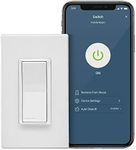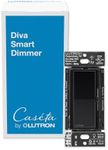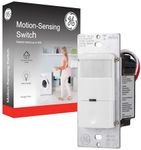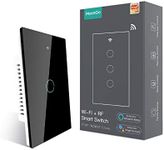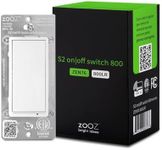Buying Guide for the Best No Neutral Wire Smart Switch
Choosing a no-neutral-wire smart switch can be a bit different from picking a regular smart switch. These switches are designed for homes where the electrical wiring does not include a neutral wire at the switch box, which is common in older houses. The right switch will let you enjoy smart lighting control without needing to rewire your home. To make the best choice, you should understand the key features and how they relate to your home setup and your needs.Compatibility with Home WiringThis spec refers to whether the smart switch can operate without a neutral wire, which is essential if your switch box lacks one. Some smart switches require a neutral wire to function, while others are specifically designed to work without it. When shopping, look for switches labeled as 'no-neutral required' or 'neutral wire not needed.' If your home is older and you’re unsure about your wiring, it’s a good idea to check behind your current switch or consult an electrician. Picking a switch that matches your wiring ensures safe and reliable operation.
Load Type SupportLoad type support means the kinds of lights or fixtures the switch can control, such as LED, incandescent, or CFL bulbs. Some no-neutral smart switches work best with certain types of bulbs, especially since they may draw a small amount of power through the load. If you use mainly LED bulbs, make sure the switch is compatible with them, as some older designs may flicker or not work properly. Always check the switch’s documentation for supported bulb types and wattage ranges to avoid issues.
Smart Home Platform IntegrationThis spec tells you which smart home systems the switch can connect to, such as Alexa, Google Assistant, Apple HomeKit, or proprietary apps. Some switches work with multiple platforms, while others are limited. Think about what smart devices you already use or plan to use, and choose a switch that fits into your ecosystem. This will make it easier to control your lights with voice commands or routines.
Installation MethodInstallation method refers to how easy it is to install the switch and whether it requires any special steps or accessories, like a bypass for certain types of bulbs. Some no-neutral switches are designed for simple DIY installation, while others may need a bit more electrical know-how. If you’re comfortable with basic wiring, look for switches with clear instructions and safety features. If not, you might want to choose a model that’s known for easy installation or consider professional help.
Switch Type (Physical Design)Switch type covers the physical design, such as whether it’s a rocker, toggle, or touch-sensitive panel. This affects how the switch feels and looks in your home. Some people prefer a traditional look, while others like modern touch panels. Think about what matches your home’s style and what you find comfortable to use daily.
Dimming CapabilityDimming capability means whether the switch can adjust the brightness of your lights, not just turn them on or off. If you want to set the mood or save energy, a dimmable switch is a good choice. However, not all no-neutral switches support dimming, and some may only work with certain types of dimmable bulbs. If dimming is important to you, make sure both your bulbs and the switch support it.
Wireless Communication ProtocolThis spec refers to how the switch connects to your smart home network, such as Wi-Fi, Zigbee, or Z-Wave. Wi-Fi switches are easy to set up and don’t need a hub, but Zigbee and Z-Wave can be more reliable in larger homes with many devices. Consider what other smart devices you have and whether you already use a hub. Choose a protocol that fits your current or planned setup for the best experience.
